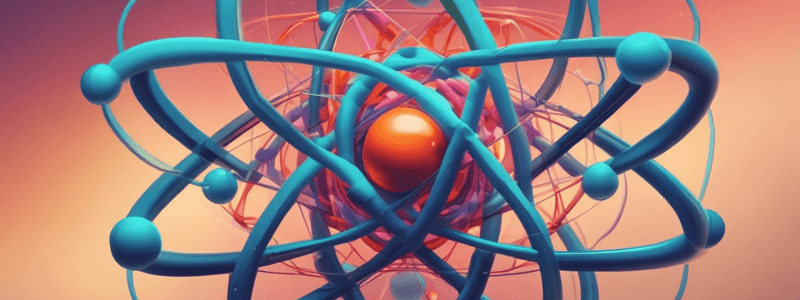Podcast
Questions and Answers
Who first used the word 'atomos' to describe indivisible particles of matter?
Who first used the word 'atomos' to describe indivisible particles of matter?
- J.J. Thomson
- John Dalton
- Democritus (correct)
- Ernest Rutherford
According to John Dalton's theory, atoms are:
According to John Dalton's theory, atoms are:
- Divisible and destructible
- Hard, indivisible, and indestructible spheres (correct)
- Composed of electrons embedded in positive material
- Orbiting the nucleus in specific energy levels
The Plum Pudding Model of the atom, proposed by J.J. Thomson, describes the atom as:
The Plum Pudding Model of the atom, proposed by J.J. Thomson, describes the atom as:
- Indivisible and indestructible spheres
- Electrons orbiting the nucleus in distinct, spherical orbits
- Positively charged material with electrons embedded within (correct)
- A compact nucleus with electrons orbiting around it
Who proposed the Saturnian Model of the atom?
Who proposed the Saturnian Model of the atom?
What experiment did Ernest Rutherford conduct to confirm the existence of a compact nucleus?
What experiment did Ernest Rutherford conduct to confirm the existence of a compact nucleus?
According to Rutherford's Nuclear Model of the atom, what happened to most of the alpha particles sent through the gold foil?
According to Rutherford's Nuclear Model of the atom, what happened to most of the alpha particles sent through the gold foil?
Who established that electrons move in distinct, spherical orbits with specific energy levels at fixed distances from the nucleus?
Who established that electrons move in distinct, spherical orbits with specific energy levels at fixed distances from the nucleus?
What experiment was used to observe the energy levels of electrons in atoms?
What experiment was used to observe the energy levels of electrons in atoms?
Which of the following models of the atom describes electrons orbiting the nucleus like the rings of Saturn orbit the planet?
Which of the following models of the atom describes electrons orbiting the nucleus like the rings of Saturn orbit the planet?
Which of the following statements is true about the development of the atomic model?
Which of the following statements is true about the development of the atomic model?
What would be the average mass of carbon if all carbon atoms were carbon-13?
What would be the average mass of carbon if all carbon atoms were carbon-13?
If there were a 50/50 mix of carbon-12 and carbon-13, what would be the average mass of all carbon?
If there were a 50/50 mix of carbon-12 and carbon-13, what would be the average mass of all carbon?
If there were 75% carbon-12 and 25% carbon-13, what would be the average mass of all carbon?
If there were 75% carbon-12 and 25% carbon-13, what would be the average mass of all carbon?
What are the actual percentages of carbon-12 and carbon-13 isotopes?
What are the actual percentages of carbon-12 and carbon-13 isotopes?
What is the atomic mass of carbon listed on the periodic table?
What is the atomic mass of carbon listed on the periodic table?
What are the abundances of the two stable lithium isotopes?
What are the abundances of the two stable lithium isotopes?
What is the weighted average atomic mass of lithium?
What is the weighted average atomic mass of lithium?
Bromine has two stable isotopes. Which isotope of bromine is more common?
Bromine has two stable isotopes. Which isotope of bromine is more common?
What are the abundances of the two stable chlorine isotopes?
What are the abundances of the two stable chlorine isotopes?
What is the weighted average atomic mass of chlorine?
What is the weighted average atomic mass of chlorine?
What is the primary difference between the Bohr model and the quantum mechanical model of the atom?
What is the primary difference between the Bohr model and the quantum mechanical model of the atom?
What are nucleons?
What are nucleons?
How is the atomic number of an element determined?
How is the atomic number of an element determined?
What is the difference between an anion and a cation?
What is the difference between an anion and a cation?
What does the symbol '$^{63}_{29}$Cu' represent?
What does the symbol '$^{63}_{29}$Cu' represent?
What is the atomic mass of an element?
What is the atomic mass of an element?
How many electrons are present in a neutral silicon atom?
How many electrons are present in a neutral silicon atom?
What is the charge of a magnesium ion with the symbol 'Mg$^{2+}$'?
What is the charge of a magnesium ion with the symbol 'Mg$^{2+}$'?
What is the mass number of the isotope '$^{35}_{17}$Cl'?
What is the mass number of the isotope '$^{35}_{17}$Cl'?
How can you determine the number of neutrons in an atom from the isotope notation?
How can you determine the number of neutrons in an atom from the isotope notation?
Flashcards are hidden until you start studying




